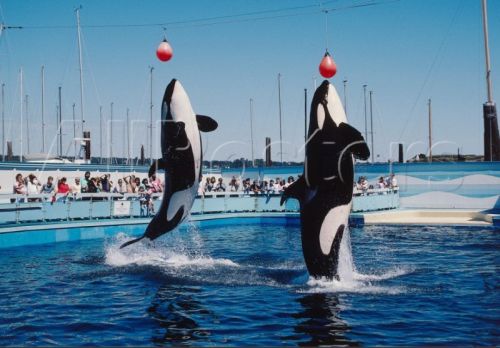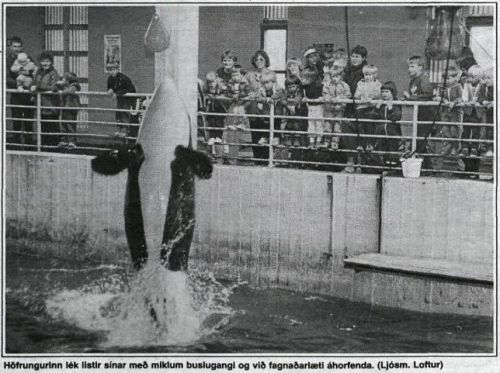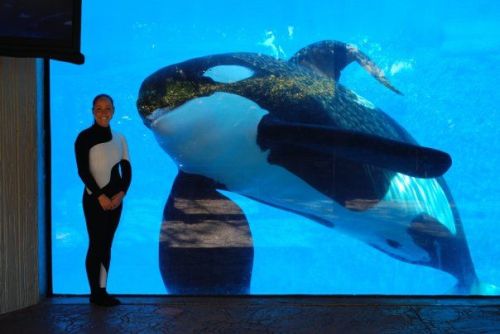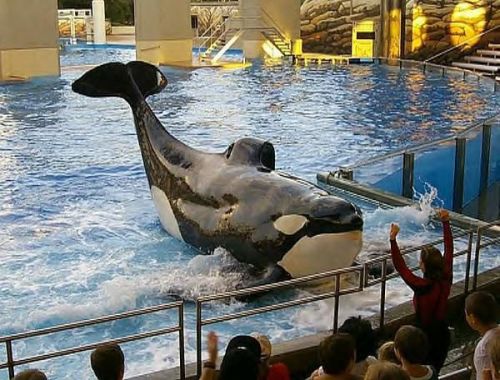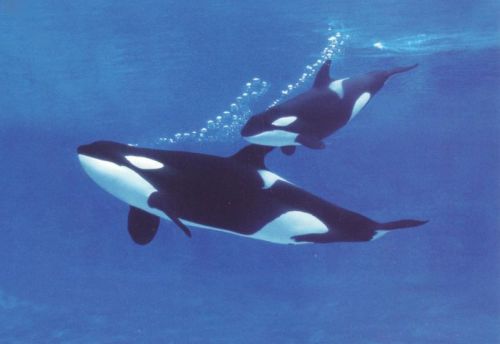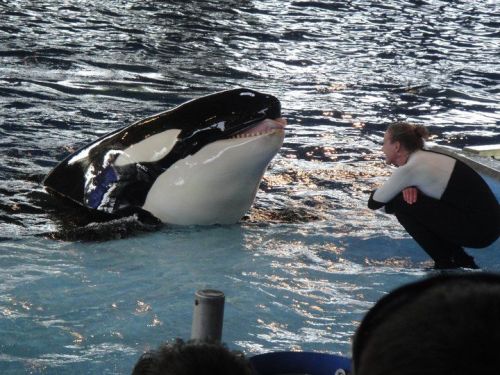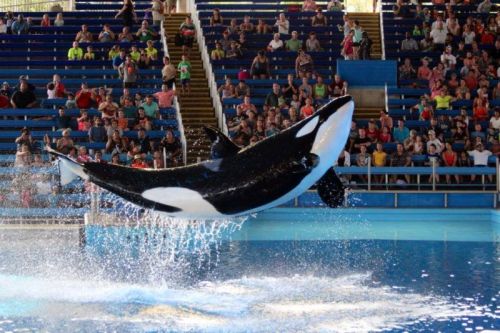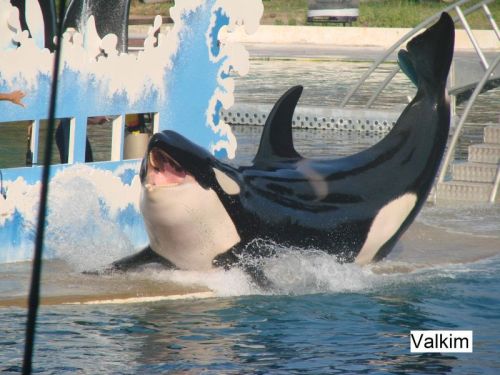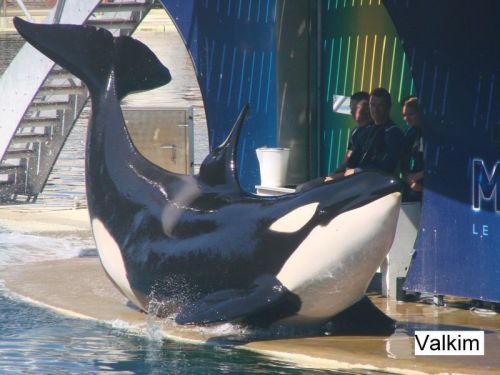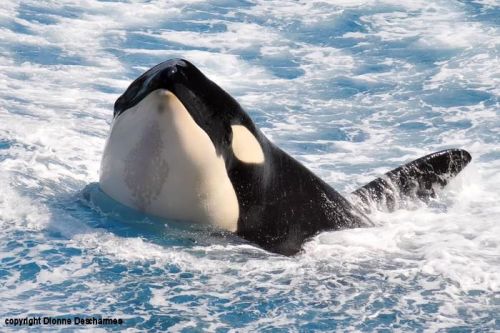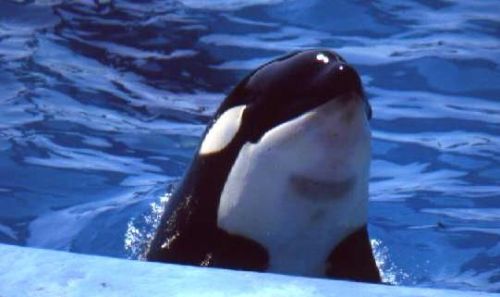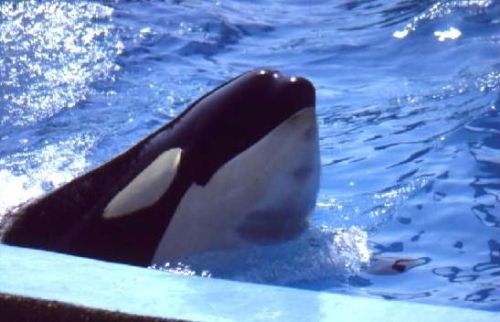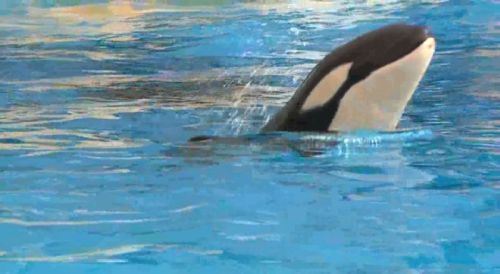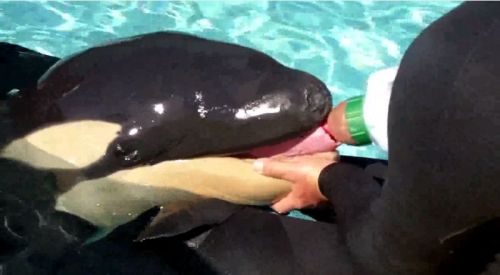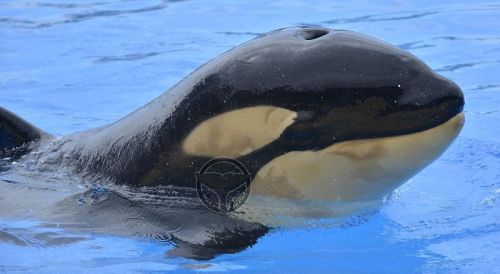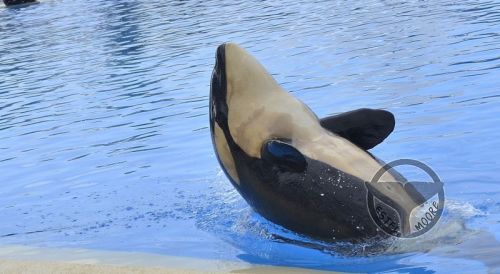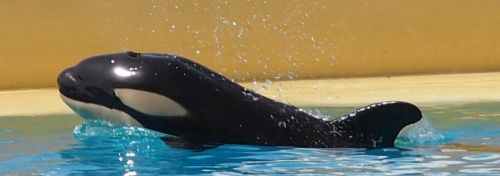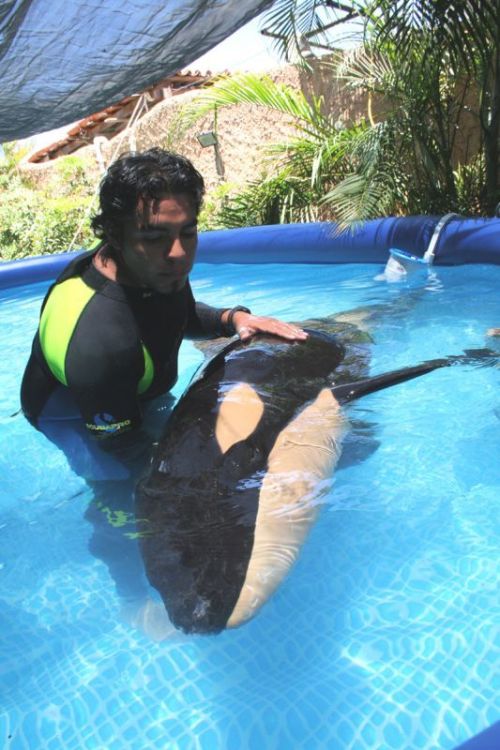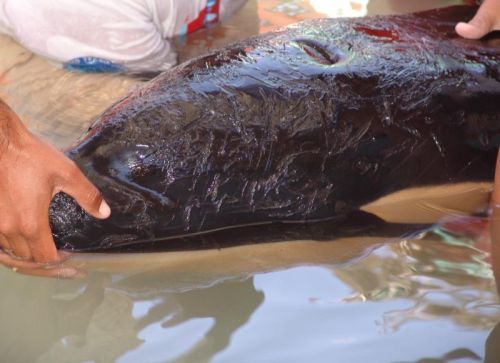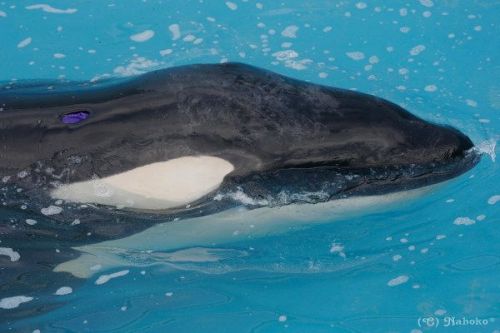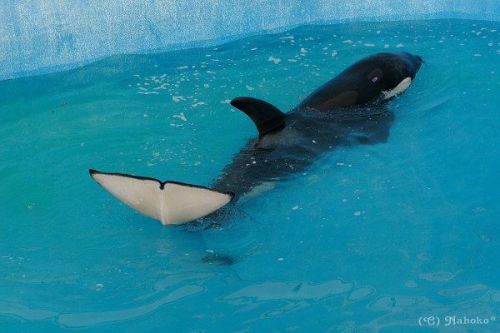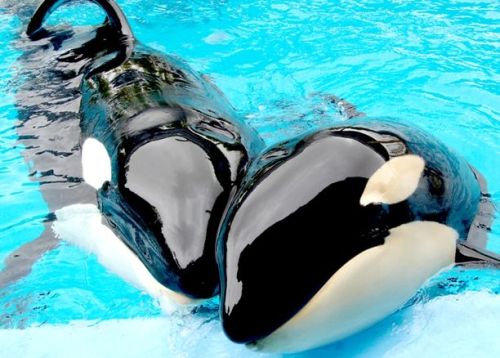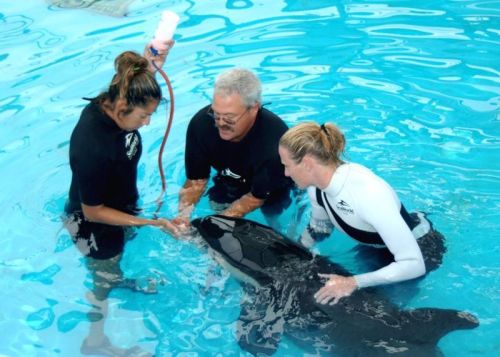#160 captives
Gender:Male
Pod:N/A
Place of Capture: Togi, Iceland
Date of Capture: November 9, 1983
Age at Capture: Approx. 2 years
On November 9, 1983, three young whales were captured off the coast of Iceland and immediately transferred to the Hafnarfjordur Aquarium. Here, they were trained and put up for sale.
The following year, a 3 year old male was purchased by Sealand of the Pacific in Victoria, Canada. He was later known as Tilikum, a Chinook Jargon word meaning “friends, relations, tribe, nation, common people”.
When he arrived at Sealand, he met the resident females, Haida II and Nootka IV who were more dominant and displaced Tilikum on a regular basis.
In 1982, a year before Tilikum arrived, Sealand housed a rescued female named Miracle who drowned after the nets were cut and she became entangled in them. This resulted in Sealand beginning to store the whales at night in the “module” - a roughly 20 x 30ft. metal pool - to prevent anymore whales from becoming entangled in the nets. According to former staff who appeared in the 2013 documentary Blackfish, when they arrived in the mornings, Tilikum would often be covered in rakes from the other whales.
The whales performed together for about 8 years until one incident caused Sealand to close down permanently.
On February 20, 1991, part-time trainer Keltie Byrne was carrying a cooler along the side of the pool before accidentally falling into the water. She attempted to climb out of the pool, but all three whales quickly swam over and pulled her away from the edge before proceeding to submerge her repeatedly until she was unconscious. Other trainers tried to distract the whales as well as pull Keltie out of the water, but were unsuccessful. Ultimately, Keltie drowned and emergency respondents were unable to retrieve her body for at least 2 hours.
At the time of the incident, both Haida II and Nootka IV were pregnant by Tilikum, though Haida II’s calf was the only one to survive, and was later named Kyuquot.
In 1992, SeaWorld stepped in and bought all four whales. Tilikum and Nootka IV were sent to the Orlando park while Haida II and Kyuquot were sent to the San Antonio park. It didn’t take long before Tilikum proved himself to be SeaWorld’s most successful breeding male ever, having sired 21 calves, though only 10 are alive today.
On July 7, 1999, Tilikum was involved in yet another incident, though this was not with a trainer, but with a park guest.
Daniel P. Dukes had visited the park the previous day, but managed to hide in the park until after closing. He then proceeded to climb into Tilikum’s tank and was found the next morning naked, covered in bruises, bite marks, and abrasions, and draped over the whale’s back. The coroner’s report concluded that Dukes’ cause of death was drowning, but goes on to list various injuries including a number of contusions, abrasions, and wounds sustained whilst he was still alive as well as postmortem, a mild subarachnoid hemorrhage of the cerebellum, and avulsion (forcible separation or detachment) of his genitals. Toxicology reports confirmed that Dukes was not intoxicated at all at the time of his death, though there are claims that he had a history of mental illness.
Tilikum had also been known to lunge towards the control trainer when he became frustrated. His profile also warned trainers of his previous incidents with Miss Byrne and Mr. Dukes. Despite trainers having to exercise caution around Tilikum, he was involved in yet another death in 2010.
On February 24, 2010, after an afternoon show resulted in several whales becoming aggressive with each other and one female sustaining an injury just above her eye near the end of the show, senior trainer Dawn Brancheau was set to perform a “Dine with Shamu” show with Tilikum.
After the show was over, Dawn continued over to a slide out area where she can be seen, in a video taken by a park guest, laying on her stomach for a ‘relationship session’ with the bull Orca. Almost immediately after lying down, Tilikum grabbed Dawn by her left arm, pulling her into the pool and beginning to violently thrash her body about in the water while at least a dozen park guests looked on in horror.
Other trainers attempted to distract Tilikum by throwing food at him and using nets but were unsuccessful. Eventually, they were able to direct him to the medical pool where he released Dawn’s body and was able to be calmed. SeaWorld went on to claim that Dawn was pulled in by her ponytail, and that Tilikum may have mistaken it for a toy or she may have touched her hair after handling fish, leaving the scent on her hair; though witnesses to Dawn’s death stated that Dawn was pulled in by her arm.
The autopsy report concluded that Dawn’s cause of death was due to drowning as well as traumatic injuries. Her injuries included complete avulsion of the scalp from the head as well as complete avulsion of her left arm. She suffered lacerations to her right ear, liver, and extremities, along with a fracture to the 7th cervical vertebra.
In Blackfish, former SeaWorld trainers noted that after Dawn had asked Tilikum for a ‘perimeter pec wave’, he did perform the behavior correctly, but missed the whistle bridge and Dawn responded with a 10 second neutral response and dismissed giving him a reward for his behavior before proceeding to ask him for a different behavior. They also noted that Tilikum could likely hear that Dawn was beginning to run out of fish, signaling that they were coming to the end of session, potentially causing him to be less focused or motivated near the end of the show.
On August 23, 2010, the Occupational Safety and Health Administration (OSHA), fined SeaWorld $75,000 for three safety violations. Most notably, one violation classified as a “willful” violation for “exposing employees to struck-by and drowning hazards when interacting with killer whales.”
SeaWorld issued a statement claiming that OSHA’s findings were “unfounded” and announced plans to contest the citation. OSHA said that trainers should not be allowed to swim with the remaining whales unless they are protected by a physical barrier or “through the use of decking systems, oxygen supply systems or other engineering or administrative controls that provide the same or a greater level of protection for the trainer.”
While SeaWorld attempted to contest the ban of waterworks, Tilikum was isolated and was not allowed to perform in shows until March 2011, and was often only seen performing in splash sessions with his grandson Trua - who was born in 2005 to the captive born female Takara. Tilikum was briefly removed from shows in December 2011 after becoming ill with Bronchitis, but recovered and resumed performances in the spring of 2012.
In April 2014, after a long court battle, a U.S. appeals court panel upheld the ruling by OSHA that SeaWorld violated its duties by exposing trainers to “recognized hazards” when working with the whales, and must limit whale-trainer contact during shows. This ban effectively removed trainers from the water and prohibits them from interacting with the whales without supervision and physical barriers in the form of removable metal bars. Though it sparked outrage among faithful SeaWorld supporters, so far, SeaWorld has chosen not to file an appeal with the United States Supreme Court.
In early March of 2016, SeaWorld announced that Tilikum was seemingly in failing health due to a bacterial infection in his lungs. Over the course of the year, updates on the bull Orcas health were scarce - though it seems that he did appear in some shows.
Unfortunately, on January 6, 2017, SeaWorld made the announcement that the 36-year old whale had died as a result of a bacterial lung infection.
x|x|x|x|x|x|x|x|x|x|x|x|x|x|x|x|x|x|x|x|x|x|x |x
Post link
Gender:Female
Pod:N/A
Place of Capture: Born at SeaWorld of Florida
Date of Capture: Born on December 27, 1996
Age at Capture: Captive born
On December 27, 1996, the Icelandic female Katina gave birth to her fourth calf at SeaWorld Orlando; a female named Unna sired by the Icelandic male Tilikum. As she grew, Unna spent a lot of time with her mother, as well as with her brother Taku, and half-siblings, Kalina and Tuar.
In 2002, Unna was transferred to SeaWorld San Antonio in Texas. Here, she met some of her nieces, nephews, and half-siblings. Her half-brother Tuar joined her at the park in 2004, and in 2006, Unna gave birth to her first calf; though the calf was, unfortunately, a stillborn. It is unknown whether she was artificially inseminated or was impregnated by one of her relatives living at the park with her.
While Unna is known to be gentle with trainers and has never had a recorded incident with anyone, she has reportedly displayed harmful stereotypical behavior in the past. According to former SeaWorld trainer John Hargrove, Unna was ‘obsessed’ with picking at the paint at the bottom of the show pool. “Unna used to destroy her face. Sometimes it would get so bad she wasn’t allowed in the front pool until her face healed,” Hargrove said. “Then we would let her out and try to prevent it. Sometimes she would leave it but eventually her focus would always go back to it. And once her focus went back to it it was an obsession, and she would do it until she injured herself.”
Unna apparently peeled such large patches of paint off the floor that it became a problem for trainers during waterwork, who often depended on the floor drains to locate themselves correctly in the pool for specific stunts. The dark patches looked so much like the pool drains that trainers had a hard time positioning themselves.
On September 22, 2015, SeaWorld posted to their SeaWorld Cares blog, stating that Unna had become ill and was under 24 hour watch due to suspected cystitis caused by a fungal infection. Less than a month later, another update was posted that mentioned a new treatment would be administered to Unna. Her condition had not improved, and veterinarians decided to try a medical treatment that had worked for humans for over a decade, but had not yet been used on an animals such as a Killer Whale.
As time went on, SeaWorld continuously posted updates regarding Unna’s care and her condition, but she did not seem to be improving, and was still under 24 hour intensive care.
Finally, on December 21, 2015, Unna unfortunately died after battling a resistant strain of Candida fungus. Necropsy results released by SeaWorld on February 6, 2016 reveal that Unna’s ultimate cause of death was due to a Systemic Bacterial Infection, also known as Septicemia/Sepsis.
Post link
Gender:Male
Pod:N/A
Place of Capture: Born at Marineland Antibes, France
Date of Capture: Born February 13, 1996
Age at Capture: Captive born
On February 13, 1996, Icelandic female Freya gave birth to her only living calf at Marineland Antibes in France; a male named Valentin sired by Kim II. Freya had previously had two stillbirths prior to Valentin’s birth, and proceeded to have two more stillbirths afterwards.
Valentin was very close with his mother and half-sister Shouka before Shouka was moved to America. He could often be seen performing with his mother, Freya, but didn’t seem to care for interacting with the public at the underwater viewing area.
As he grew, Valentin’s dorsal had remained somewhat straighter and more erect than other captive males, possibly due to Marineland Antibes large 11 million-gallon tank complex for the whales. He was also known for a strange marking on his chin. It is unclear what it was, but it had been present for many years and did not seem to get better or worse.
Valentin is also believed to be the father of Keijo, a calf born in 2013 to Valentin’s half-sister, Wikie; meaning that Valentin would be both Keijo’s uncle and his father. However, Keijo seems healthy and appears to be doing well.
On June 20, 2015, the park was dealt a heavy blow when Freya died suddenly after a long battle with an unknown illness. Since Freya was the matriarch of the Marineland France park, it was unclear how her death would affect the social structure of the remaining 5 Orca. The fact that Valentin had been closest to his mother was particularly worrying, as wild male Orca sometimes don’t fare well after their mothers death.
On October 3rd, massive flash-flooding devastated the south of France. It also wiped out nearly 90% of the filtration and electrical systems at Marineland, causing many of the parks animals to die and turning the Orca tanks a murky greenish-black color due to mud and various other debris, possibly including toxic chemicals and substances like gasoline. It was soon learned that Marineland, despite having been flooded and closed in the past, did not have any emergency plans.
Unfortunately, on October 12, 2015, Valentin died suddenly due to Intestinal Volvulus (twisted intestine) at just 19 years old. He had not shown symptoms of the illness until a few hours before his death.
Post link
Gender:Female
Pod:N/A
Place of Capture: Stokkseyri, Iceland
Date of Capture: October 1982
Age at Capture: Approx. 1 year
Sometime in October 1982, a group of five whales were captured off the coast of Stokkseyri, Iceland. They were immediately transferred to the Hafnarfjordur Aquarium where they were trained and put up for sale.
By March of 1983, a young female, later known as Freya, was purchased by Marineland Antibes in France, along with Kim II - a male she had been captured with. When they arrived at the park, they met Betty, the resident female who displaced Freya and showed dominance over her. However, they soon began to get along until Betty’s death in 1987, resulting in Freya becoming the dominant whale at the park.
In 1986, Freya had Pleurisy (inflammation of the tissues that line the lungs and chest cavity). While having x-rays taken, she suffered a radiation burn that took 3 years to heal and left a permanent, circular white scar.
Marineland soon purchased two new whales named Sharkan and Tanouk in 1990. Freya was pregnant by Kim II before they arrived, but in 1991, Freya delivered a stillborn. She had another stillborn in 1993, and was put on medication due to possible depression caused by the loss of her calves. The same year, Sharkan gave birth to a female calf named Shouka.
In February of 1996, Freya gave birth to her first and only live calf, a male named Valentin whom she was very close with. Freya went on to have two more stillbirths - one in 2001 and another in 2003.
Afterwards, she was placed on birth control and kept on medication for her depression. She was later taken off birth control in hopes of being artificially inseminated, but she never became pregnant.
While Freya lived a life in captivity mostly without incident, she was involved in an incident with one trainer in 2008, in which she repeatedly attempted to submerge him underwater and pushed him around the tank. At one point in a video taken by a park guest, the trainer can be seen with his hands in Freya’s mouth, though he was able to exit the tank without any serious injuries.
On June 20, 2015, Freya died suddenly after a lengthy battle with an illness - though the illness that caused her death has not been disclosed to the public. Unfortunately, four months later on October 12, Valentin, Freya’s only living calf, also died due to Intestinal Volulus (twisted intestines).
Post link
Gender:Female
Pod: N/A (Mother was Kohana)
Place of Capture: Captive born
Date of Capture: Born August 3, 2012
Age at Capture: Captive born
On February 13, 2006, four young Orcas were sent from SeaWorld to Loro Parque in Spain.
Keto, Tekoa, Kohana, and Skyla had been sent to the park on a breeding loan, though many were shocked at these choices, as all four whales were closely related. The two females were only 2 and 3 years old at the time as well, meaning they had never learned the skills on how to properly raise their own calves from their mothers.
However, the park persisted in breeding their whales and on August 3, 2012, Kohana gave birth to her second calf, sired by her uncle Keto, when she was just 10 years old.
Just like her first calf, a male named Adán, also sired by Keto and born when Kohana was only 8 years old, Kohana immediately rejected her second calf; a female known as Victoria, or Vicky.
Kohana paid no attention to Vicky and staff had to step in to hand-rear Vicky just like they had with Adán.
Vicky seemed to do well, however. She was eating well, playing with her older brother in the medical pool. Though, the majority of her life was spent alone with inflatable toys and trainers as her companions.
However, she began exhibiting changes in her behavior, and a SeaWorld veterinarian had been flown out to the park.
Unfortunately, on June 16, 2013, Vicky died due to Intestinal Complications at only 10 months old.
Post link
Gender:N/A
Pod: N/A (Mother was Taima)
Place of Capture:N/A
Date of Capture:N/A
Age at Capture:N/A
Stillborn calf of unknown gender born to captive born female Taima on June 6, 2010 at SeaWorld Orlando.
Taima went into labor on June 5th, her labor lasting into the next day as she struggled to expel the calf; though it unfortunately resulted in her death.
Post link
Gender:Female
Pod:N/A
Place of Capture: Bay of Mantanchén, Mexico
Date of Capture: April 10, 2007
Age at Capture: Approx. a few weeks
On April 10, 2007, a very young female calf was found stranded in the Bay of Mantanchén in Mexico.
Later known as Pascuala, she was covered in wounds that were likely the result of fishing nets, and was thought to be only a few weeks old; though some sources claim she still had part of the umbilical cord attached.
Because there were no other Orcas sighted in the area, Pascuala was transported to a pool at a restaurant at Borrego Beach where her health was assessed.
The next day, she was transferred to a dolphinarium in Vallarta. Here, she was kept in a small pool, as swimming was difficult for her without any help. She was fed and kept under volunteer supervision 24 hours a day.
Plans were soon made to fly Pascuala to SeaWorld San Diego for better care. However, organizations such as Greenpeace, as well as the Mexican government’s environmental protection agency, blocked the transfer. Mexican wildlife conservation laws do not allow the exporting of marine mammals, so Pascuala was to stay in Mexico.
However, Pascuala did make improvements every day, and was soon moved to a larger pool. She became more active and enjoyed the company of humans, but was introduced to the park’s dolphins, who were apparently fearful of her, even though she was playful and friendly towards them.
By the end of April, her daily interactions with humans was reduced to only a few hours in the water, as opposed to 24 hours a day just weeks before. Volunteers described her as depressed and less active. Pascuala even lost weight despite how much she was eating.
Caretakers did their best to try and keep her alive, but Pascuala died on June 10, 2007. Her official cause of death is listed as Immune System Failure, Malnutrition, and Infection.
Post link
Gender:Male
Pod: N/A (Mother was Kayla)
Place of Capture:N/A
Date of Capture:N/A
Age at Capture:N/A
Stillborn calf born to Kayla at SeaWorld Orlando sometime in April 2007. Kayla had been pregnant during her 2006 transfer from the Texas park to the Florida park; it is unknown if this contributed to the death of her unborn calf.
Post link
Gender:Female
Pod: N/A (Mother was Unna)
Place of Capture:N/A
Date of Capture:N/A
Age at Capture:N/A
Stillborn calf born to Unna at SeaWorld Texas sometime in April 2006.
Post link
Gender:Male
Pod:N/A
Place of Capture: Katsuura, Chiba, Japan
Date of Capture: February 10, 2006
Age at Capture: Approx. 3-4 years
On February 10, 2006, a young male Orca was found stranded on a beach near Katsuura, Japan. He was apparently too weak to be pushed back out to sea, and was instead transferred to Kamogawa Sea World to receive care.
He was severely underweight and had difficulty swimming, so staff had to work around the clock.
Unfortunately, he died on February 13, 2006 due to unknown causes just 3 days after his stranding.
Post link
Gender:Female
Pod: N/A (Mother was Kayla)
Place of Capture: Captive born
Date of Capture: Born October 9, 2005
Age at Capture: Captive born
On October 9, 2005, captive born female Kayla gave birth to her first calf, a female named Halyn, at SeaWorld Texas.
However, Kayla, who was inexperienced as a mother, rejected Halyn immediately and showed no interest in her calf at all, apparently even becoming aggressive towards her. As a result, staff were forced to step in, separate the pair, and hand-rear Halyn.
Halyn was kept out of public view in the animal care section of the park where a female Bottlenose Dolphin was introduced as a temporary companion. Staff used Kayla’s milk to create a formula in order to bottle-feed Halyn, who was fed every two hours and monitored around the clock.
When she reached 3 months old, she was moved back to Shamu Stadium where she met the other whales through the gates.
In 2007, Halyn was introduced to her father, Keet. Unfortunately, she would never meet her mother, as Kayla was moved to the Orlando park in 2006.
She was able to join Keet in shows and was learning quickly, even beginning to learn waterwork behaviors.
Unfortunately, Halyn died suddenly on June 15, 2008 due to Acute Necrotizing Encephalitis, a disorder that causes swelling of the brain.
Post link
Gender: N/A
Pod: N/A (Mother was Ran)
Place of Capture: Captive born
Date of Capture: Born August 26, 2004
Age at Capture: Captive born
On August 26, 2004, Icelandic female Ran gave birth to her first calf, presumably a female sired by the Japanese male Kyu. The calf was the first to be born at Nanki Shirahama Adventure World.
Unfortunately, the calf was born premature and had a broken skull.
The calf died on August 28, 2004, just two days after it’s birth as a result of it’s condition. Ran also died the following day.
Post link


